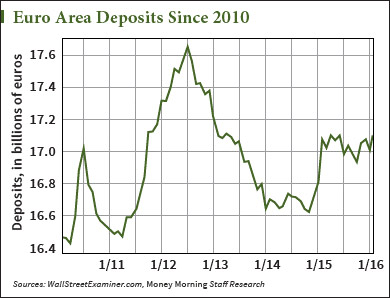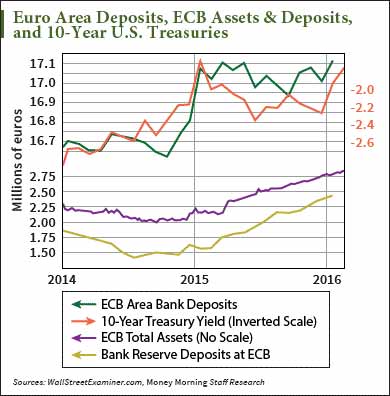A funny thing happened while central banks were racing to make money cheap as free...
U.S. bank loan and deposit growth continues to go bonkers at annual growth rates of more than 8% for loans and around 6% for deposits.
Across the Atlantic, where negative-interest-rate policy (NIRP) is an ugly reality, loan and deposit growth in Europe is near zero - and that's in spite of the fact that Mario Draghi and his merry band of central bankers have thrown everything but the kitchen sink at their system to try to get it to grow.
But Draghi & Co. don't seem to realize their actions are killing Europe's markets while propping ours up.
It's going to end badly for the Europeans, but this insanity tends to create tremendous opportunities in American markets.
"NIRPitrage" Is Killing Europe...
Draghi is so barking mad right now that he's forgotten the first lesson they teach you in banker school...
Money goes where it's treated best. And right now, capital is flowing from Europe to the United States faster than Draghi can print it.
This is so simple, even a caveman would get it. But unfortunately, if you put 12 central bankers in a room, they'll just lock the door to keep reality out.
Capital is rolling west because Europe has negative interest rates and the United States has positive interest rates. It's very simple math: 0.36% is greater than -0.3%.
Big investors, speculators, businesses, and securities dealers all have the option of where to send and keep their money, and if Europe is stupid enough to tax them for keeping cash there, then by god, they'll just move it somewhere else.
They'll move it to where it's safe, and where they can still earn some semblance of a positive return, however minuscule.
And that place is the good old U.S. of A., "land of the free and home of the half point" (which, by the way, could be heading higher soon).
As crazy as I think the Fed is, they are beacons of sanity in the delusional world of central bankers.
Then again, insanity is relative, and in this case, that glimmer of sanity probably provides just enough clarity for the Fed to recognize that positive rates in the United States help to keep the Great American Ponzi Scheme growing... as long as Europe and Japan are negative.
Those flows to the U.S. would grow even more if the Fed raised rates. It's not quite quantitative easing, it's a new kind of QE, "quantitative expropriation."
The European Central Bank and the Bank of Japan do the quantitative easing, then the Fed pays just a little more for it, and the cash comes flowing across the sea in massive waves.
...But Europe's Leak Is Lifting America's Boat
ECB data on bank deposits for the Eurozone shows that while total bank deposits upticked in January, they have remained virtually range-bound for past the year.

Now, money-printing in the form of the ECB's asset purchases should cause a euro for euro increase in deposits, but that has not occurred.
That's because a substantial portion of the ECB's newly printed money flees the Eurozone altogether to avoid the NIRP tax. Total deposits are barely higher than the level reached when the ECB began outright QE in March 2015.
Considering that the ECB has printed and pumped about €650 billion ($728 billion) into the European banking system since then, it's clear that the system has sprung a very large leak.
This chart below shows exactly where the leak is going; it shows the correlation between the ECB's asset growth and the size of its various deposit facilities - what economists call "reserves" - along with the correlation to total European bank deposits, and with the direction of U.S. Treasury bond prices.
Note the correlation between European bank deposits and the direction of U.S. Treasury note prices (yield inverse) at the top of the chart.
From this, we can know that some European deposit holders have been buying Treasuries. I have shown charts similar to this in the past that depict this correlation over the long term. This chart shows what has happened since the ECB started NIRP in June 2014.

The lower half of the chart shows that as the ECB purchases assets (green line), there is a like increase in bank reserve deposits at the ECB.
Gone Today... Here Tomorrow
This is basic Accounting 101. The ECB buys the bonds from the banks by crediting their deposit accounts at the ECB with money it materializes by waving its magic money wand through the electronic ether.
[mmpazkzone name="in-story" network="9794" site="307044" id="137008" type="4"]
Those reserve deposits, which didn't exist prior to that moment, instantly become very real and absolutely immutable. It's like the Hotel California at the ECB's headquarters in Frankfurt - they can move around on the liability side of the ECB's balance sheet, but they can never leave.
Banks can get rid of their reserve deposits by buying assets from other banks, dealers, investors, businesses, or governments, but that only leaves another bank with the reserve deposit.
Somebody will always be stuck paying the interest on the deposit.
That makes those reserve deposits a hot potato that nobody wants, but nobody can escape as cash circulates through the banking system.
The problem for the bag-holding banks is that when they try to pass on the negative interest rates to customers, those customers with international connections do the rational thing... because, unlike central bankers, they are not insane.
Deposit holders find the best option for their cash outside the European banking system, and the deposit leaves that system for greener pastures, most often in the United States.
Those deposits move frequently via the purchase of U.S. Treasury securities or even U.S. stocks. When the depositor buys Treasuries or U.S. stocks, his bank exchanges his euro deposit for U.S. dollars and transfers the U.S. dollars into the U.S. account of the seller of the Treasuries. That could be a dealer, another investor, or the US government itself. The euro-denominated deposits are thus converted to dollars and become U.S. bank deposits.
This is basic interest rate arbitrage, and NIRP exacerbates that to the nth degree. That's how the ECB can pump €650 billion into the European banking system, and deposits in that system manage not to grow at all.
Depositors aren't stupid. They're getting the hell out of Dodge.
The only stupid ones are Mario Draghi and his fellow central banksters at the ECB - and, more recently, the Bank of Japan. These lunatics are keeping the Great American Ponzi Scheme markets rolling while doing absolutely nothing for Europe.
As insane as the Fed's central bankers may be, I suspect that they are just lucid enough to understand the benefits of "NIRPitrage" to the American Ponzi game. Of course, a crisis could always drive them to play with negative rates themselves, as our Shah Gilani said yesterday, but the Fed may just follow through on its threat to gradually raise the sham fed funds rate (nobody really trades fed funds).
The bigger the gap between positive rates in the United States and negative rates in Europe becomes, the more capital will be encouraged to flee Europe and float U.S. bond prices higher.
As we've seen recently, and as I previously forecast at WallStreetExaminer.com, it has also been enough to foment intermittent rallies in U.S. stocks.
This ridiculous pattern can go on for a long, long time if the Fed doesn't interrupt it. While buy and hold is certainly dead, these policies result in tremendous trading opportunities on both long and short sides of the market for those who are paying attention. My weekly reports on liquidity flows, and daily reports on the technical conditions in the U.S. markets, help you to do that.
Follow Money Morning on Facebook and Twitter.
About the Author
Financial Analyst, 50-year charting expert, finance + real estate pro, and market analyst; published and edited the Wall Street Examiner since 2000.



